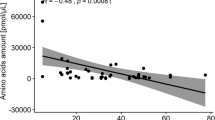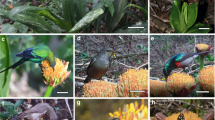Abstract
Globally, two bird–pollination systems have been recognised, involving specialist and occasional nectar-feeding birds. Whether avian pollinators place selective pressure on the plants they feed on, in terms of flower morphology and nectar traits, is still debated. While considerable research exists that examines the sugar preferences, concentration preference and digestive ability of specialist nectar-feeding birds, there is little known about these parameters for occasional nectar-feeding birds, as most previous studies have not controlled for the energetic value of solutions employed in choice experiments. Birds of the Sturnidae–-Muscicapoidea lineage lack sucrase and are intolerant of solutions or fruit above 11–15% sucrose content. African Red-winged Starlings Onychognathus morio are occasional nectarivores that play a role as pollinators of several plant groups, particularly aloes, which produce large amounts of dilute floral nectar. We confirmed that these birds, like other members of their lineage studied outside of Africa, are unable to digest sucrose. In laboratory trials, they strongly preferred hexose (1:1 glucose:fructose) over sucrose solutions in paired equicaloric choice tests at a range of concentrations (5–20%) and maintained energy balance at these concentrations. However, they were unable to maintain body mass when given a choice between sucrose and hexose solutions at the highest concentration (25%) and showed no sugar preference at this level, suggesting that high concentration solutions may place physiological stress on starlings. Starlings preferentially consumed lower concentration solutions, when simultaneously offered four hexose solutions of varying concentrations (10–25%). These results suggest that starlings impose pollinator-mediated pressure for low concentration, hexose-rich nectar in the plants they pollinate.
Zusammenfassung
Afrikanische Rotschwingenstare bevorzugen Hexose-Zuckerlösungen, mögen es jedoch nicht zu süß
Allgemein sind zwei Systeme der Bestäubung durch Vögel bekannt, die spezialisierte und gelegentliche Nektarfresser einbeziehen. Ob Blumenvögel Selektionsdruck auf die Pflanzen, deren Nektar sie fressen, hinsichtlich Blütenmorphologie und Nektareigenschaften ausüben, wird nach wie vor diskutiert. Während Zuckerpräferenzen, Konzentrationspräferenzen und Verdauungsfähigkeiten spezialisierter nektarfressender Vögel gut untersucht sind, ist über diese Parameter bei gelegentlich nektarfressenden Vögeln nur wenig bekannt, da die meisten bisherigen Studien den Energiewert der in Wahlversuchen verwendeten Lösungen nicht berücksichtigt haben. Vögel der Sturnidae-Muscicapoidea-Abstammungslinie haben keine Saccharase und vertragen keine Lösungen oder Früchte mit mehr als 11–15% Saccharosegehalt. Afrikanische Rotschwingenstare Onychognathus morio sind gelegentliche Nektarfresser, die eine Rolle als Bestäuber verschiedener Pflanzengruppen spielen, insbesondere von Aloen, die große Mengen verdünnten Blütennektars produzieren. Wir bestätigten, dass diese Vögel, ebenso wie andere untersuchte Mitglieder ihrer Abstammungslinie außerhalb Afrikas, nicht in der Lage sind, Saccharose zu verdauen. In Laborversuchen zeigten sie eine starke Präferenz für Hexoselösungen (1:1 Glucose:Fructose) im Vergleich zu Saccharoselösungen, in gepaarten äquikalorischen Wahlversuchen mit verschiedenen Konzentrationen (5–20%), und erhielten ihre Energiebalance bei diesen Konzentrationen aufrecht. Sie waren jedoch nicht in der Lage, ihre Körpermasse aufrechtzuerhalten, wenn sie die Wahl zwischen Saccharose- und Hexoselösungen der höchsten Konzentration (25%) hatten, und zeigten keine Präferenz für einen bestimmten Zucker bei dieser Konzentration. Dies deutet darauf hin, dass stark zuckerhaltige Lösungen für die Stare physiologischen Stress bedeuten könnten. Die Stare konsumierten vorzugsweise Lösungen niedrigerer Konzentration, wenn ihnen gleichzeitig vier Hexoselösungen unterschiedlicher Konzentration (10–25%) angeboten wurden. Diese Ergebnisse deuten darauf hin, dass Stare Selektionsdruck auf die Pflanzen, die sie bestäuben, ausüben, dahingehend, dass diese schwach konzentrierten, hexosereichen Nektar produzieren.




Similar content being viewed by others
References
Bene F (1945) The role of learning in the feeding behavior of black-chinned hummingbirds. Condor 47:3–22
Blem CR, Blem LB (2000) Rufous hummingbirds sucrose preference: precision of selection varies with concentration. Condor 102:235–238
Botes C, Johnson SD, Cowling RM (2008) Coexistence of succulent tree aloes: partitioning of bird pollinators by floral traits and flowering phenology. Oikos 117:875–882
Brown KJ, Downs CT (2003) Digestive efficiency of a generalist avian feeder, the Cape White-eye (Zosterops pallidus). Comp Biochem Physiol Part A 134:739–748
Brown M, Downs CT, Johnson SD (2008) Sugar preferences of nectar feeding birds–a comparison of experimental techniques. J Avian Biol 39:479–483
Brown M, Downs CT, Johnson SD (2009) Pollination of the red hot poker Kniphofia caulescens by short-billed opportunistic avian nectarivores. S Afr J Bot 75:707–712
Brown M, Downs CT, Johnson SD (2010a) Concentration-dependent sugar preferences of the Malachite Sunbird Nectarinia famosa. Auk 127:151–155
Brown M, Downs CT, Johnson SD (2010b) Sugar preferences and digestive efficiency in an opportunistic avian nectarivore, the dark-capped bulbul. J Orn 151:637–643
Brown M, Downs CT, Johnson SD (2010c) Sugar preferences of a generalist non-passerine flower visitor, the African speckled mousebird. Auk 127:781–786
Brugger KE (1992) Repellency of sucrose to captive American robins. J Wild Manag 56:794–799
Brugger KE, Nelms CO (1991) Sucrose avoidance by American Robins (Turdus-Migratorius)—implications for control of bird damage in fruit crops. Crop Prot 10:455–460
Brugger KE, Nol P, Phillips CI (1993) Sucrose repellency to European starlings: will high-sucrose cultivars deter bird damage to fruit? Ecol App 3:256–261
Collias NE, Collias EC (1968) Anna’s Hummingbirds trained to select different colors in feeding. Condor 70:273–274
Downs CT (1997) Sugar digestion efficiencies of Gurney’s sugarbirds, malachite sunbirds, and black sunbirds. Physiol Zool 70:93–99
Fleming PA, Bakken BH, Lotz CN, Nicolson SW (2004) Concentration and temperature effects on sugar intake and preferences in a sunbird and a hummingbird. Funct Ecol 18:223–232
Fleming PA, Xie S, Napier K, McWhorter TJ, Nicolson SW (2008) Nectar concentration affects sugar preferences in two Australian honeyeaters and a lorikeet. Funct Ecol 22:599–605
Franke E, Jackson S, Nicolson SW (1998) Nectar sugar preferences and absorption in a generalist African frugivore, the Cape white-eye Zosterops pallidus. Ibis 140:501–506
Fraser MW (1990) Food of Redwinged Starlings and the potential for avian dispersal of Acacia cyclops at the Cape of Good Hope Nature Reserve. S Afr J Ecol 1:73–76
Gatica CDL, Gonzalez SP, Vasquez RA, Sabat P (2006) On the relationship between sugar digestion and diet preference in two Chilean avian species belonging to the Muscicapoidea superfamily. Rev Chil Hist Nat 79:287–294
Hoffman MT (1988) The pollination ecology of Aloe ferox Mill. S Afr J Bot 54:345–350
Jackson S, Nicolson SW, Van Wyk BE (1998a) Apparent absorption efficiencies of nectar sugars in the Cape sugarbird, with a comparison of methods. Physiol Zool 71:106–115
Jackson S, Nicolson SW, Lotz CN (1998b) Sugar preferences and “side bias” in Cape sugarbirds and lesser double-collared sunbirds. Auk 115:156–165
Johnson SD, Nicolson SW (2008) Evolutionary associations between nectar properties and specificity in bird pollination systems. Biol Lett 4:49–52
Johnson SD, Hargreaves AL, Brown M (2006) Dark, bitter-tasting nectar functions as a filter of flower visitors in a bird-pollinated plant. Ecology 87:2709–2716
Karasov WH, Cork SJ (1996) Test of a reactor-based digestion optimization model for nectar-eating rainbow lorikeets. Physiol Zool 69:117–138
Lane S (1997) Preferences and apparent digestibilities of sugars by fruit damaging birds in Japan. Ann Appl Biol 130:361–370
Leseigneur CDC, Nicolson SW (2009) Nectar concentration preferences and sugar intake in the white-bellied sunbird, Cinnyris talatala (Nectariniidae). J Comp Physiol B 179:673–679
Lopez-Calleja MV, Bozinovic F, Martinez del Rio C (1997) Effects of sugar concentration on hummingbird feeding and energy use. Comp Biochem Physiol A 118:1291–1299
Lotz CN, Nicolson SW (1996) Sugar preferences of a nectarivorous passerine bird, the lesser double-collared sunbird (Nectarinia chalybea). Funct Ecol 10:360–365
Lotz CN, Schondube JE (2006) Sugar preferences in nectar- and fruit-eating birds: behavioral patterns and physiological causes. Biotropica 38:3–15
Malcarney HL, Martinez del Rio C, Apanius V (1994) Sucrose intolerance in birds: simple nonlethal diagnostic methods and consequences for assimilation of complex carbohydrates. Auk 111:170–177
Martinez del Rio C (1990) Sugar preferences in hummingbirds: the influence of subtle chemical differences on food choice. Condor 92:1022–1030
Martinez del Rio C, Stevens BR (1989) Physiological constraint on feeding behavior: intestinal membrane disaccharidases of the starling. Science 243:794–796
Martinez del Rio C, Karasov WH, Levey DJ (1989) Physiological-basis and ecological consequences of sugar preferences in cedar waxwings. Auk 106:64–71
Martinez del Rio C, Avery ML, Brugger KE (1995) Sucrose as a feeding deterrent for fruit-eating birds. USDA National Wildlife Research Center Symposia National Wildlife Research Center Repellents Conference. University of Nabraska, Lincoln, p 353–369
Martínez del Rio C, Daneke D, Andreadis PT (1988) Physiological correlates of preference and aversion for sugars in three species of birds. Physiol Zool 61:222–229
Martínez del Rio C, Baker HG, Baker I (1992) Ecological and evolutionary implications of digestive processes: bird preferences and the sugar constituents of floral nectar and fruit pulp. Experientia 48:544–551
Martínez del Rio C, Schondube JE, McWhorter TJ, Herrera LG (2001) Intake responses in nectar feeding birds: digestive and metabolic causes, osmoregulatory consequences, and coevolutionary effects. Am Zool 41:902–915
Mata A, Bosque C (2004) Sugar preferences, absorption efficiency and water influx in a Neotropical nectarivorous passerine, the bananaquit (Coereba flaveola). Comp Biochem Physiol A 139:395–404
Odendaal TC, Brown M, Downs CT, Johnson SD (2010) Sugar preferences and digestive efficiency of the village weaver: a generalist avian pollinator of African plants. J Exp Biol 213:2531–2535
Ornelas JF, Ordano M, De-Nova AJ, Quintero ME, Garland T (2007) Phylogenetic analysis of interspecific variation in nectar of hummingbird-visited plants. J Evol Biol 20:1904–1917
Ortega-Olivencia A, Rodriguez-Riano T, Valtuena FJ, Lopez J, Devesa JA (2005) First confirmation of a native bird-pollinated plant in Europe. Oikos 110:578–590
Rodriguez–Rodriguez MC, Valido A (2008) Opportunistic nectar-feeding birds are effective pollinators of bird-flowers from Canary Islands: experimental evidence from Isoplexis canariensis (Scrophulariaceae). Am J Bot 95:1408–1415
Schmidt-Lebuhn AN, Schwerdtfeger M, Kessler M, Lohaus G (2007) Phylogenetic constraints versus ecology in the nectar composition of Acanthaceae. Flora 202:62–69
Schondube JE, Martinez del Rio C (2003) Concentration-dependent sugar preferences in nectar-feeding birds: mechanisms and consequences. Funct Ecol 17:445–453
Stiles FG (1976) Taste preferences, color preferences, and flower choice in hummingbirds. Condor 78:10–26
Stromberg MR, Johnsen PB (1990) Hummingbird sweetness preferences: taste or viscosity? Condor 92:606–612
Symes CT, Nicolson SW (2008) Production of copious dilute nectar in the bird-pollinated African succulent Aloe marlothii (Asphodelaceae). S Afr J Bot 74:598–605
Symes CT, Nicolson SW, McKechnie AE (2008) Response of avian nectarivores to the flowering of Aloe marlothii: a nectar oasis during dry South African winters. J Ornithol 149:13–22
Symes CT, Human H, Nicolson SW (2009) Appearances can be deceiving: pollination in two sympatric winter-flowering Aloe species. S Afr J Bot 75:668–674
Tamm S, Gass L (1986) Energy intake rates and nectar concentration preferences by hummingbirds. Oecologia 70:20–23
Van Wyk BE, Whitehead CS, Glen HF, Hardy DS, Van Jaarsveld EJ, Smith GF (1993) Nectar sugar composition in the subfamily Alooideae (Asphodelaceae). Biochem Syst Ecol 21:249–253
Wellmann AE, Downs CT (2009) Sugar preferences and digestion by Cape white-eyes, Zosterops virens, fed artificial diets. Afr Zool 44:106–116
Witmer MC (1999) Do avian frugivores absorb fruit sugars inefficiently? How dietary nutrient concentration can affect coefficients of digestive efficiency. J Avian Biol 30:159–164
Acknowledgments
We thank Ebrahaim Ally and Lorinda Jordaan for assistance in bird capture. Thamsanqa Mjwara oversaw bird maintenance. Erin Wreford and Robyn Hartley are thanked for assisting in data collection for the assimilation efficiency trials. Sindiso Chamane and Sindisiwe Nzama assisted with the preference trials. We are grateful to the National Research Foundation for funding. The experiments carried out in this study were approved by the Animal Ethics sub-committee of the University of KwaZulu-Natal.
Author information
Authors and Affiliations
Corresponding author
Additional information
Communicated by C. G. Guglielmo.
Rights and permissions
About this article
Cite this article
Brown, M., Downs, C.T. & Johnson, S.D. African Red-winged Starlings prefer hexose sugar solutions, but do not like them too sweet. J Ornithol 153, 265–272 (2012). https://doi.org/10.1007/s10336-011-0739-5
Received:
Revised:
Accepted:
Published:
Issue Date:
DOI: https://doi.org/10.1007/s10336-011-0739-5




